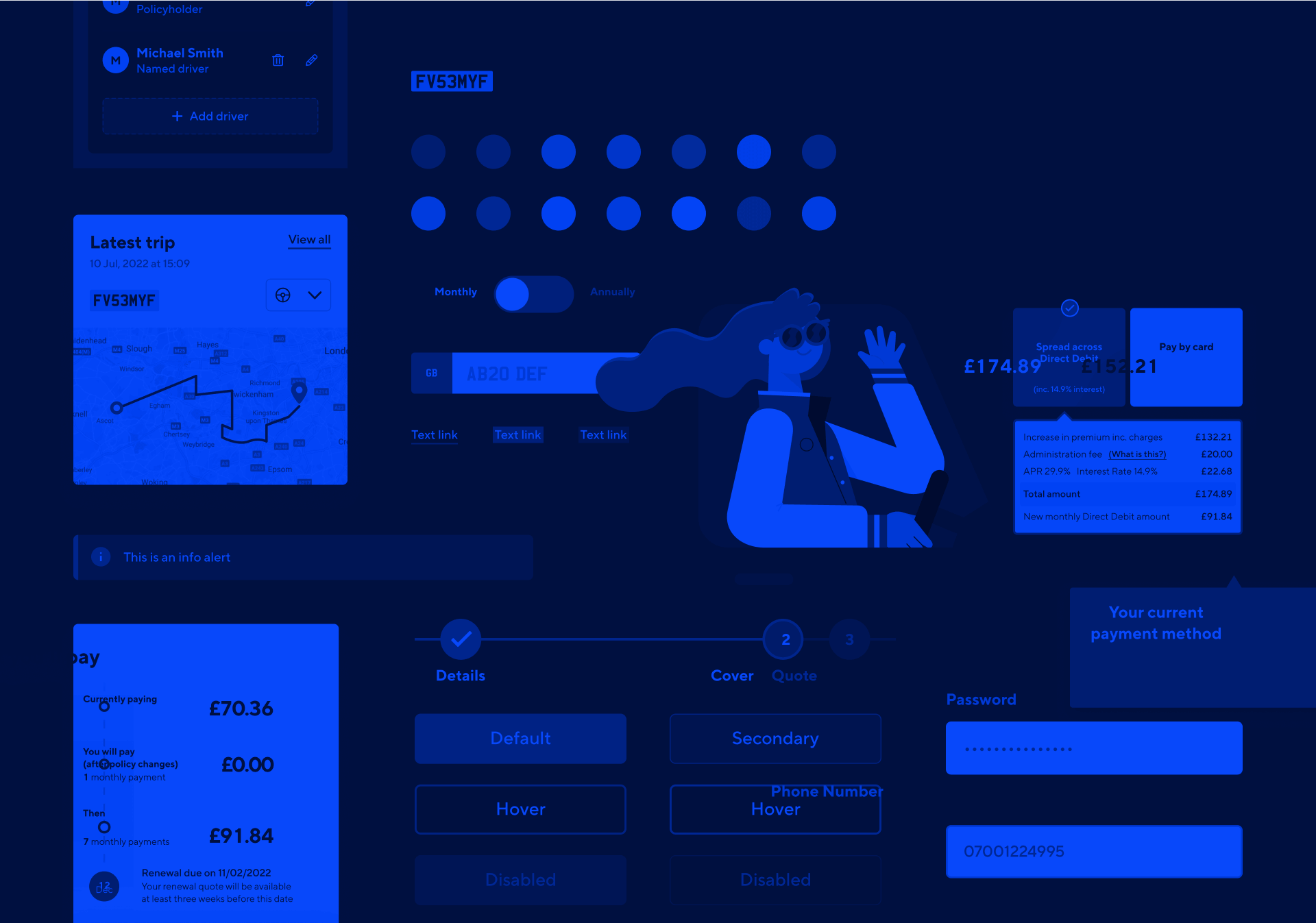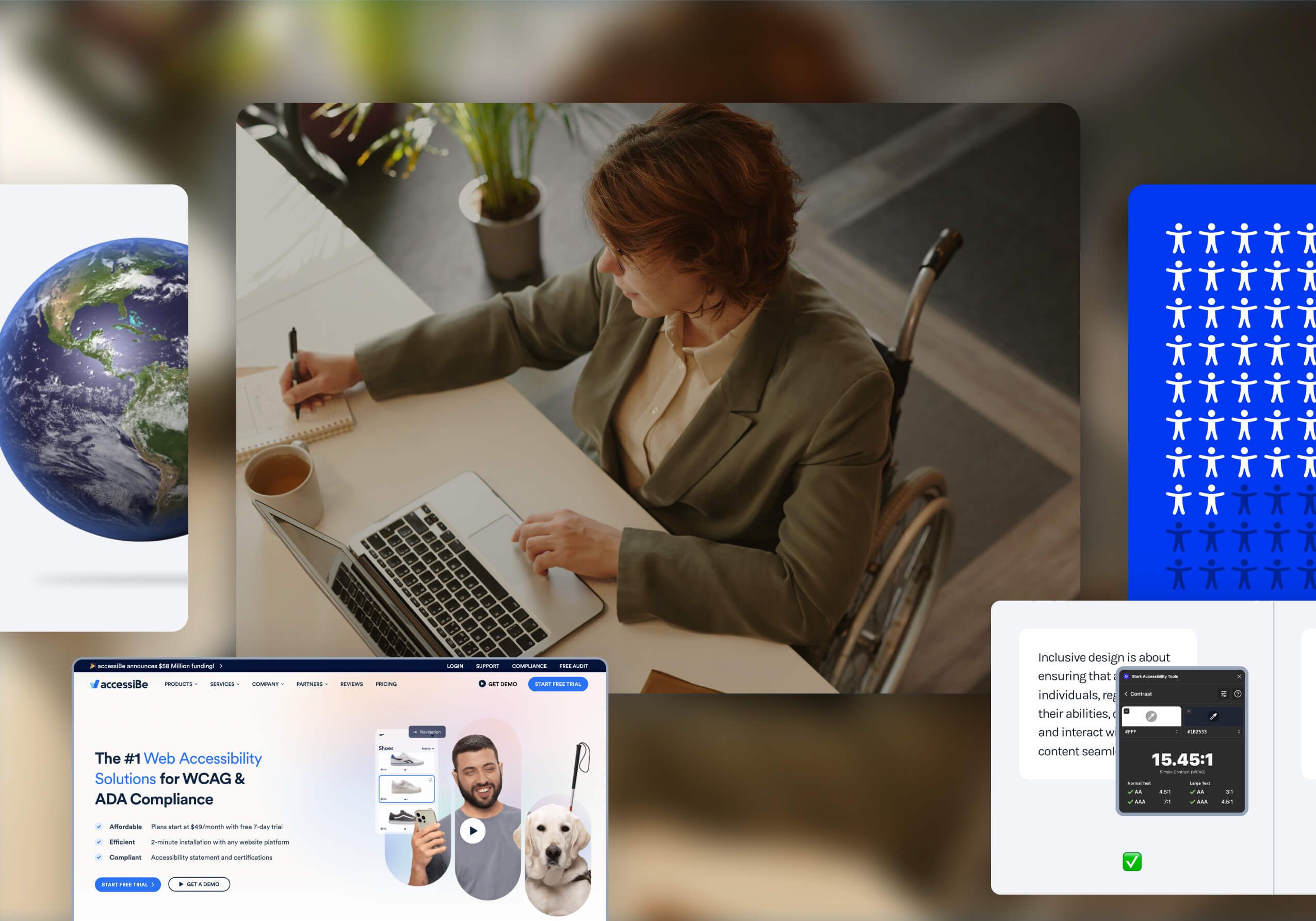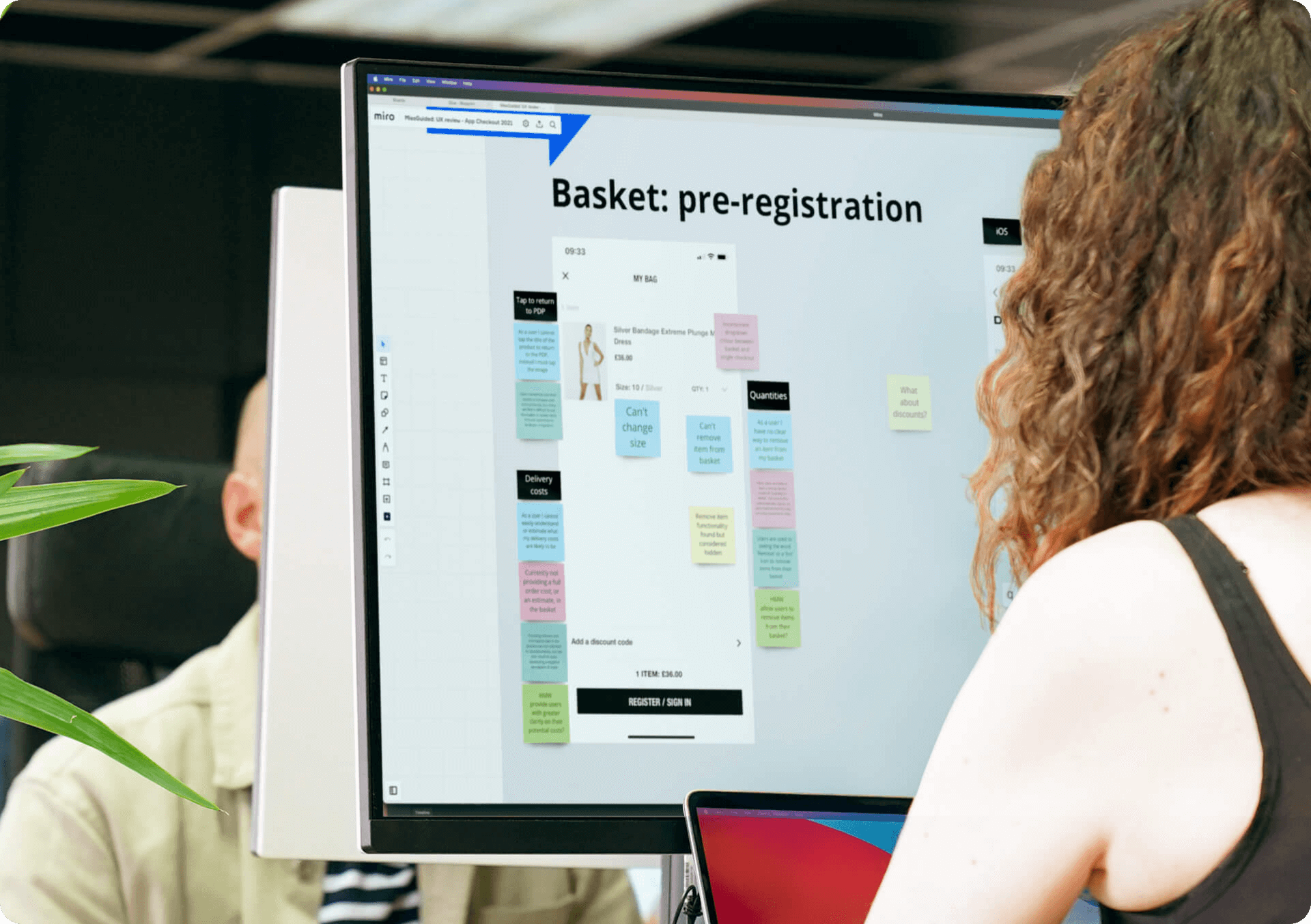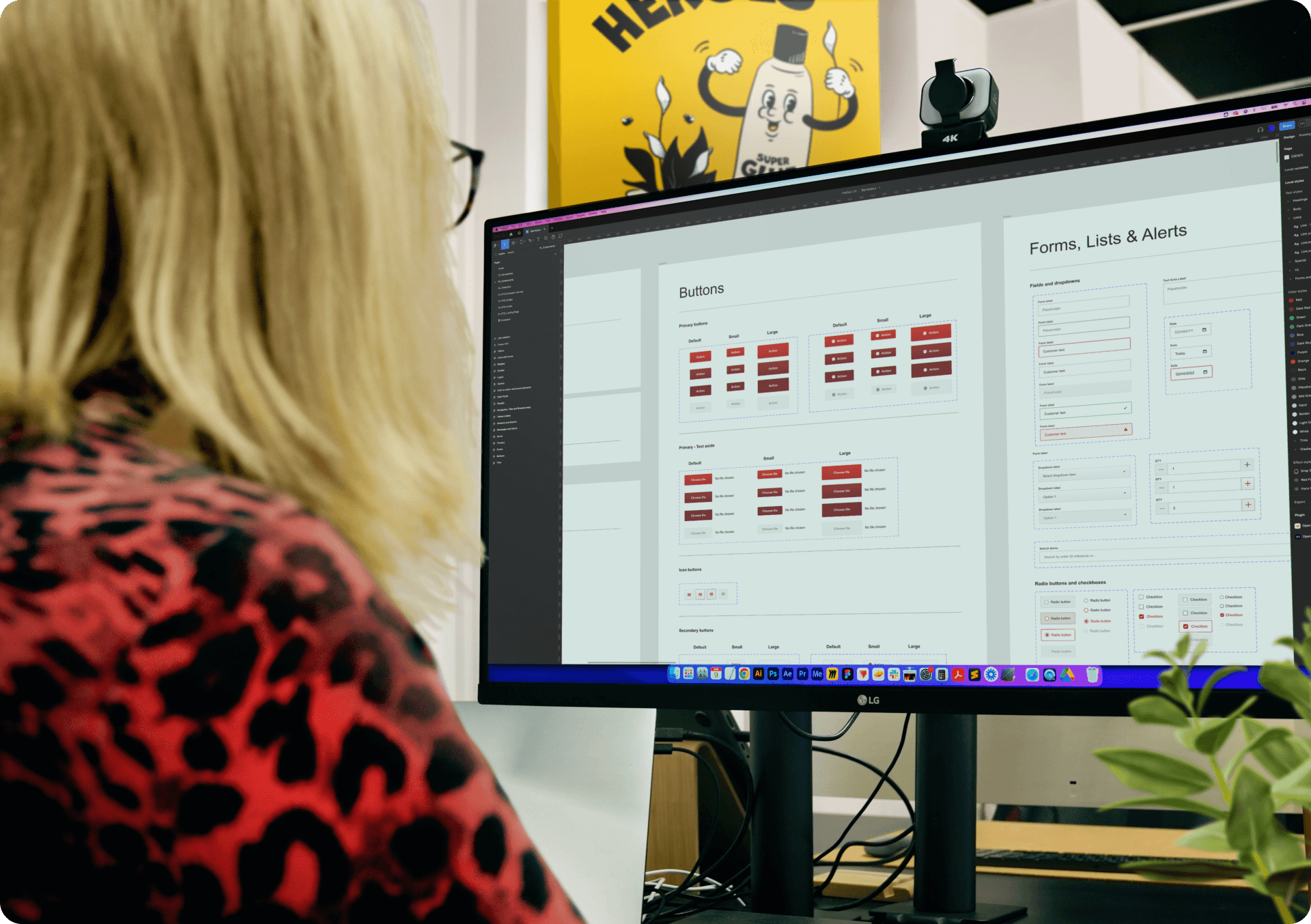Contents
Duty to your consumers: ensuring accessibility across digital products
In this report, we’ll navigate the upcoming needs of the Consumer Duty Act 2023 and the wider-reaching regulatory landscapes of the UK, EU, and US for accessibility. As we delve into the challenges faced by various companies serving consumers with disabilities, we’ll explore innovative tools to mitigate these issues, strategies to elevate customer experience, and tactical input for digital product design.
From Alarm to Opportunity
Compliance, inclusivity, and strategic advantage in your digital products
If you’re not familiar with the Consumer Duty Act, it refers to the duty of care companies have for their customers, ensuring that they receive value for money and come to no harm. Set by the FCA, it’s a reminder to financial companies that customer-first thinking is not just kind, it’s necessary. And by customers, we mean everyone, particularly those who are vulnerable.
...customer-first thinking is not just kind, it’s necessary.
While the Consumer Duty Act specifically targets financial services companies, its principles should echo across all industries. It serves as a powerful reminder that customer-centricity isn’t just good practice, it’s mandatory. Disregarding such rules and regulations can lead to more than just sanctions, it can be a strategic mishap. The Act’s cornerstones; accessibility, clarity, simplicity, and support, ensure engaging and respecting customers, no matter the sector.
The current Equality Act 2010 is always ready to dish out penalties to those who neglect accessibility. Equally, if you’re operating in the EU, the EU Web Accessibility Directive has set its own expectations to ensure digital inclusivity. Across the pond in the USA, Section 508 calls for firms to adopt the global Web Content Accessibility Guidelines (WCAG), and the Americans with Disabilities Act (ADA) tackles discrimination and implies equal digital access for those with disabilities. So, wherever you operate, inclusive digital design is, quite rightly, legally mandated.
With possible legal ramifications, hefty fines, and a PR mess in the offing, swift compliance is vital. Beyond just meeting legislative requirements, it’s about unlocking the potential of a vastly untapped market. With the deadline for full compliance set for July 31, 2024, think of the Consumer Duty Act less as a legal maze and more as a timely alarm, an alarm we can help silence! Let’s explore how to plan and design your way to a more accessible, compliant, and financially rewarding future!
Key Dates for Consumer Duty
30 April 2023
Complete all necessary reviews for existing products and services and identify where changes need to be made.
31 July 2023
Implementation deadline for new and existing products or services that are open to sale or renewal.
31 July 2024
Implementation deadline for closed products or services.
Decoding the Landscape
Insights, challenges, and opportunities in the realm of digital accessibility
As we navigated the realm of accessibility and inclusivity, we uncovered compelling insights beyond mere numbers. This narrative depicted how organisations, consumers, and regulatory bodies are resonating with the cry for universal digital accessibility. What lies ahead is not just a series of statistics - it's a reflection of a shifting paradigm, laying bare the trends, challenges, and opportunities.
Digital inclusivity snapshot
16% of the global population lives with a disability. An aging population is expected to increase this number, affecting industries across the board. In the UK, there are 14.6 million people with a form of disability, equating to a representation of £17.1 billion in consumer spending. Globally, people with disabilities represent a market larger than China, controlling over $13 trillion in disposable income.
38.6% of employees reported that accessibility influenced customers' purchasing decisions, clearly indicating a growing awareness of inclusivity in consumer choices. Due to inaccessibility, UK businesses lose £2 billion monthly. A sobering reminder of the economic cost of neglecting accessibility.
72% of adults with disabilities own a smartphone. 5.7% of U.S. adults struggle with serious hearing difficulties. By 2050, nearly 2.5 billion people globally will have some degree of hearing loss.
Digital accessibility is a daily necessity for a substantial percentage of the population.
The average homepage hosts 50.8 detectable accessibility errors, showing clear room for improvement in making digital spaces accessible to all. Fortune 100 companies were found to have 815,600 accessibility issues, demonstrating that even industry giants are failing to meet basic accessibility standards.
Manual testing is necessary to detect up to 70% of accessibility issues. An investment of resources that businesses need to seriously consider. 64% of businesses were committed to digital accessibility in 2020, up from 59% in 2019, reflecting a growing trend toward prioritising digital inclusion. 25.3% of web accessibility practitioners cite morality as their motivation, further evidence that doing the right thing is becoming an industry standard. Companies saw an uptake in UX hires, underlining the industry-wide shift towards creating more inclusive experiences. 61.7% of organisations aim to provide the best user experience for all, a powerful testament to the commitment to universal accessibility.
Brands that are leading the charge
Apple
Apple is a business giant that places accessibility at the forefront of its innovation. Their suite of features to support individuals with disabilities is impressive, from VoiceOver, a gesture-based screen reader, to Live Listen, aiding those with hearing impairments. Not to mention, they also enforce accessibility standards for all their apps in the App Store.
Microsoft
Microsoft, on the other hand, is transforming the gaming industry with its Xbox Adaptive Controller, a gaming device designed primarily for individuals with limited mobility. This revolutionary product reiterates the power of inclusive design, which not only benefits individuals with disabilities but also broadens the market reach.
BBC
BBC's approach to accessibility is also commendable. Their in-house accessibility team ensures that all digital products are designed and developed with inclusivity in mind. They've even developed their own mobile accessibility guidelines, setting the bar high for other media companies.
How our clients lead the charge
At Hastings Direct, we embed usability and accessibility throughout our design and delivery processes, making every team member accountable for excellent customer outcomes. This proactive approach not only enhances satisfaction but also demonstrates our dedication to inclusivity, reinforcing our commitment to high-quality products and services.

At Staysure; inclusivity and accessibility are two words that mean so much more to us than actions to be ticked off on a to-do list. We're working hard to ensure that even our most vulnerable customers have access to the products and services that give them the peace of mind they need to enjoy even more life-affirming experiences. The very essence of those two words is infused into every product, service, and interaction that we design, craft, and bring to life.
Tech tools that are changing the game
In a world where digital inclusivity is becoming more than just an expectation, it's paramount to have the right tools in your arsenal. They will simplify the complex task of making your digital products accessible and provide a superior user experience that caters to everyone's needs. Here's a glimpse of four powerful tools that are making waves in the arena of digital accessibility.
AccessiBe
With its AI-powered applications, AcessiBe transforms inaccessible code into an inclusive digital experience. It offers a session-based widget that users can customise, modifying colour contrast or disabling flash, for a browsing experience tailored to their individual needs.
Google Lighthouse
Lighthouse, an open-source automation tool, strives to enhance the functionality, quality, and precision of your web applications. By conducting a series of tests on a webpage, it generates a comprehensive report, signifying the performance level of the page.
Stark
Stark is not just a plugin; it's a comprehensive accessibility toolkit. Integrated with design tools and browsers, it provides contrast checkers, vision simulators, design suggestions, alt-text annotations, and even WCAG audits. Stark guides users to enhance the inclusivity of their digital products effectively.
A11Y
A11Y embodies a commitment to digital inclusivity, enabling compatibility with assistive technologies. This approach not only facilitates universal design but also unlocks vital opportunities, making technology accessible and essential for all, especially those with disabilities
The Consumer's Voice
Insights and the digital accessibility journey
In a digitally connected world, the user experience shapes our perceptions and drives our interactions. When we focus on accessibility, these experiences become far more than just anecdotal evidence, they shape the narrative of inclusivity and inspire action. Here, we delve into lived-through experiences of users interacting with digital products, highlighting the impact of accessibility on their everyday lives, and the urgency for comprehensive digital inclusivity.
Behind every statistic and compliance requirement, there's a real person, having a real life experience facing barriers.
Every day challenges faced by users with disabilities range from filling out an online form to navigating a poorly structured website. These experiences underline the need for a more accessible digital world. The voice of users is loud and clear; they demand digital inclusivity.
Meanwhile, the legal landscape reflects a growing impatience with the lack of action towards digital accessibility. The surge in ADA-related lawsuits is a clear sign that users are willing to fight for their rights. Notably, the landmark case of Gil v. Winn-Dixie highlighted the courts' interpretation of websites as "places of public accommodation," thereby falling under the scope of the ADA.
Looking at these developments, the legal, ethical, and business requirements for digital accessibility cannot be overstated. These stories and legal precedents remind us that behind every statistic is a human life affected, making accessibility a crucial aspect of designing and developing digital products.
Users' frustration with inaccessible websites is growing. Consider a Twitter user lamenting over missing alt text on images, equating it to viewing a series of blank pictures. While it's beyond Twitter's control to ensure users add alt text, they could certainly push more strategies to remind users of its importance.
Regrettably, even when alt text is present, misuse often leads to distress for those reliant on assistive technologies like screen readers. The improvements made thus far in digital accessibility seem to fall short of satisfying the needs of the disabled community.
The disabled community is demanding equal digital rights and accessibility. Their dissatisfaction is real and their message is clear: the need for digital accessibility is urgent, and it is now.
Performance Showdown
Benchmarking accessibility across digital landscapes
In the world of digital accessibility, there are several gold-standard businesses to look up to. From giants like Apple and Google, who lead the pack with their dedication to making products and platforms accessible, to players like Microsoft and Airbnb, who have made substantial strides in integrating accessibility into their core design principles, we can learn a lot from their approach.
In our quest for inclusivity, comparing ourselves against the benchmark set by the industry is not just beneficial, but crucial. Through a meticulous audit of various digital products and websites across diverse industries, we identify the leaders, glean lessons from their strategies, and pinpoint areas that call for improvement.
Here’s what we’ve found:
Clear, concise, and well-structured content
Making information easy to understand and navigate helps all users, especially those using assistive technology.
Left-aligned text
Aligning text to the left aids in readability, considering the left-to-right reading pattern of many Latin alphabet languages. The ‘NHS’ and ‘Next’ websites are prime examples, maintaining consistent left alignment across all pages.
Colour contrast
Colour contrast is critical for users with visual impairments. 'The Works' excels in this aspect, ensuring text and interactive elements stand out against their backgrounds. Conversely, certain sections of 'Dreams' fall short of the WCAG AA standard.
Appropriate use of colour
Colour should not be the sole means of conveying important information, as it can be missed by colour-blind users.
Text link differentiation
Making text links visually distinctive enhances user interaction. With clear hover states, such as darkening text and adding underlines, these elements become more identifiable. 'Carpetright' could improve here as many of their text links lack a hover state.
Focus states
Highlighting focus states is crucial for users with disabilities. ‘Wickes’ and ‘Tripadvisor’ do this well, outlining focused elements with a blue box, whereas 'I Saw It First' could better indicate where users are on the page.
Large target areas & CTAs
Larger target areas boost accessibility, aiding users with motor disabilities or touch devices. '.Gov' implements this effectively, with large interactive elements and well-designed CTAs. ‘B&Q’ are another example of a website doing this well.
Images with ALT tags
Alt text allows users with visual impairments, or using assistive tech to understand images. '.Gov' shines here again, with descriptive ALT tags on almost all images. ‘Missguided’ does particularly well with ALT tags on their imagery, whereas, ‘Halfords’ was a mixed bag, with only some images containing ALT tags.
Keyboard-friendly site design
Ensure that all website features can be accessed via a keyboard, catering to users who cannot use a mouse.
Closed captions and transcripts
These aid users who are D/deaf or hard of hearing, and also enhance the user experience for those who prefer reading to listening.
Through the lens of these tools; Google Lighthouse, Stark, and Ax DevTools, we conducted our evaluation, offering us a comprehensive, multi-faceted understanding of digital accessibility. This comparison isn't just about scoring points; it's a journey toward learning, adapting, and ultimately making the digital world more accessible to everyone.
The Cost of Not
The legal implications of overlooking inclusivity and accessibility
You may believe you’re treading on safe grounds with the Consumer Duty Act being freshly minted, thinking the storm has passed. Don’t be lulled into complacency. The absence of fines today doesn’t mean tranquility tomorrow. If history and international trends are anything to go by, the threat looms larger than ever. In the US, companies can be instantly fined for inaccessible websites, with the fines ballooning if not rectified swiftly. As disability legislation strengthens, so do civil lawsuits. Giants like Nike, Netflix, and Amazon have already fallen into the crosshairs of accessibility lawsuits. Some speculate that predatory law firms are now hunting for non-compliant websites, preying on vulnerabilities for profit.
While lawsuits remain rarer in the UK, it’s a game of Russian roulette you wouldn’t want to play. The numbers are staggering in the US. By the end of 2023, an estimated 4,220 lawsuits under the Americans with Disabilities Act (ADA) will be filed. Shockingly, 19% of these are against repeat offenders. Visual and auditory disability plaintiffs lead the charge, and a staggering 95% of these companies are expected to settle due to the sheer weight of legal fees, many in the tens of thousands of dollars. The initial violation fee is a jaw-dropping $75,000, doubling with each subsequent transgression.
Remember the Domino’s Pizza lawsuit? Guillermo Robles was awarded $4,000 because he couldn’t access their online services. This might seem a small sum for a corporation, but what if thousands followed suit? As Chris Danielsen poignantly puts it:
This is not about whether a guy can order pizza from a particular pizza restaurant, it’s about whether blind people are going to be able to participate in society in the 21st century.
Companies ignoring this are not just risking finances, but their reputation and, more importantly, their moral compass. Avoid being next.
Magic Gifts
Transforming accessibility challenges into opportunities for all
The future is rapidly evolving, and with it, the digital landscape. Companies must be proactive in their approach, ready to adapt, innovate, and lead the charge toward universal digital accessibility. In this final section, we outline the steps you can take toward an accessibility-focused, future-proof strategy.
The goal of any digital product is to create a functional and enjoyable experience for the user. Failing to incorporate accessibility can alienate a significant demographic, which is why it needs to be front and centre in our design process. This not only broadens the product's appeal, but, can also lead to a higher-quality final product.
By embedding accessibility from the outset, we stimulate innovative thinking that considers diverse user needs and preferences. This inclusive approach often triggers the discovery of new and improved design features that benefit all users, not just those with disabilities. Universal design principles guide us toward creating products that are user-friendly, intuitive, and adaptable, thus enhancing the product's overall appeal.
Inclusive design plays a pivotal role in the ever-evolving landscape of product management within the insurance market. In an industry traditionally driven by risk assessment and actuarial calculations, adopting an inclusive approach can be transformative. It ensures that insurance products are accessible and beneficial to a diverse range of customers, regardless of their background, abilities, or unique needs. By prioritising inclusivity, product managers can tap into previously underserved markets, foster customer loyalty, and enhance brand reputation. Moreover, inclusive design isn't just a moral imperative; it's increasingly becoming a legal requirement in many jurisdictions, reinforcing the need for insurance products that are fair and equitable for all. In summary, embedding inclusive design principles into product management not only fosters innovation but also empowers insurers to better serve their clients and thrive in an ever-competitive industry.
Here’s what you can do:
Accessibility audit
Conduct a comprehensive accessibility audit of your current digital products to identify gaps and areas of improvement. Remember, this isn't a one-time activity but a recurring process. Regular audits ensure you are keeping up with changing technology and customer needs.
Inclusive design
From the start, adopt an inclusive design process that considers a broad spectrum of abilities. Engage diverse user groups in your design process, conduct user testing, and validate your assumptions. Consider inclusivity as a design principle, not a user problem.
Culture of Accessibility
Foster a culture of accessibility within your organisation. Make sure every stakeholder, from your designers and developers to your marketers, understands the importance of digital accessibility and their role in achieving it.
Tools and technologies
Leverage the power of technology to help you create accessible digital experiences. Consider AI-powered tools that can automate accessibility adaptation, and design plugins that help you adhere to accessibility standards.
Continual learning
Stay informed about the latest trends and developments in the field of digital accessibility. Regularly upskill your teams, invest in their training, and keep them updated about the latest regulations and practices.
Stakeholder engagement
Work with customers, regulators, NGOs, and industry bodies to understand the evolving landscape of digital accessibility. Be part of the conversation, and help shape the future of digital inclusivity.
Safeguarding the future
Develop a long-term strategic plan that includes not just compliance with current regulations but also anticipates future legal, social, and technological changes. Embrace digital accessibility as a core part of your organisation's strategy, not an afterthought.
In the grand scheme of things, the urgency for digital accessibility isn't just about risk mitigation or legislative compliance; it's about creating an inclusive digital landscape that caters to all users equally.
By weaving these elements into the fabric of our design process, we create a more inclusive digital landscape and unlock a world of opportunities and growth, ushering us into the next exciting chapter of digital accessibility.
Leading the Charge
Navigating the duty to consumers with accessible digital products
It's clear that the digital world is a necessity. As businesses, governments, and society as a whole become increasingly reliant on digital technology, it's our responsibility to ensure that these resources are available to all. After traversing through the landscape of digital accessibility together, it's time to take that crucial next step.
Starting with a strong foundation is essential. This means embracing inclusive design from the outset. As the digital landscape shifts, so must our approach. It's not a trend, but a necessity. While many claim inclusivity, few truly integrate it. At Glue, we don’t just talk; we act. It's about making every user feel seen and heard. Simple in theory, yet profound in practice.
We invite you to embark on this journey toward creating a more inclusive and accessible digital experience. Whether you're seeking to build an accessible product from the ground up, ready to enhance your digital accessibility, or striving to maintain compliance with rapidly evolving accessibility standards, we have the expertise, tools, and passion to help.
Our team of accessibility experts, armed with state-of-the-art AI technologies and a keen understanding of user-centric design principles, is committed to helping you meet and exceed WCAG 2.1 standards. We offer end-to-end accessibility solutions, from conducting detailed audits of your digital assets to building inclusive digital products and providing continuous support and training to your team.
But more than that, we're committed to the bigger picture; fostering a culture of inclusivity within your organisation, boosting your brand's reputation, expanding your market reach, and ultimately, creating a better digital world for all.
If you're ready to take action and create a more accessible and inclusive digital experience for your users, reach out to us. We're excited to join you on this journey and help your organisation unlock the magic gifts of digital accessibility.
Don't just adapt to the digital accessibility landscape; lead the way! Let's transform the challenges into opportunities, together.
Get in touch with us today, and let's pave your path toward an accessible digital future!
Appendix
1. https://www.fca.org.uk/firms/consumer-duty
3. https://eur-lex.europa.eu/legal-content/EN/TXT/HTML/?uri=LEGISSUM%3A4314916
4. https://www.section508.gov/
6. https://apps.who.int/iris/handle/10665/44575
7. https://www.disabled-world.com/disability/statistics/
8. https://ddiy.co/web-accessibility-statistics/
9. https://webaim.org/projects/million/
11. https://commonslibrary.parliament.uk/research-briefings/cbp-9602/
12. https://wearepurple.org.uk/the-purple-pound-infographic/
13. https://blog.hubspot.com/website/accessibility-statistics
14. https://www.accessibility.works/blog/2023-wcag-ada-website-compliance-standards-requirements/
15. https://advancedbytez.com/what-is-an-accessibility-audit/
16. https://blog.usablenet.com/new-e-book-on-ada-and-digital-accessibility
17. https://www.accessi.org/blog/famous-web-accessibility-lawsuits/
How Glue Can Help
Get in touch








































